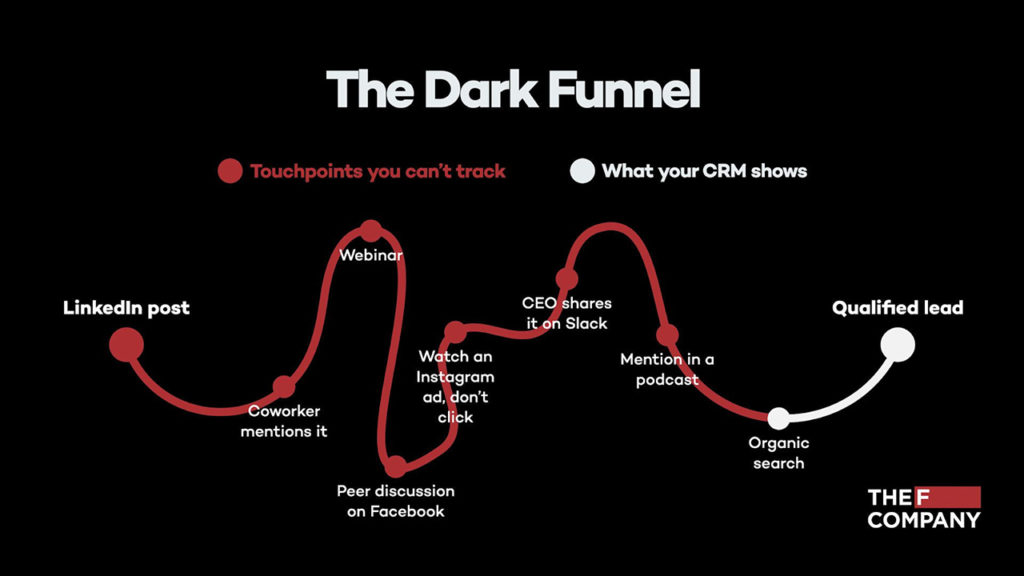We’re sure you’ve already heard of the ‘dark funnel’ of B2B marketing. It’s the fancy name for the invisible part of the customer journey—the part where your customers are aware of you, but you are not yet aware of them.
This phase is characterized by how difficult it is to measure and track. But understanding and navigating it is crucial for businesses because it is an important part of where your revenue comes from.
Hold on tight, ‘cause we’re about to tell you a trick or two about the dark funnel. In this blog, we’ll explore the dark funnel’s importance in B2B marketing and give advice on how to make good use of it.
The expectations vs. reality of a customer journey
Many CEOs think that customers simply Google search your company and instantly convert into a qualified lead. In reality, what happens though is a lot more complicated.
The real customer journey could look like this:
- A potential customer sees your company’s LinkedIn post. Maybe they don’t think much of it at the time.
- Next, their CMO mentions one of your posts on Slack.
- At some point, they are exposed to an Instagram ad, which they might not even click.
- After some time, this potential customer stumbles upon a peer discussion on Facebook. Your company’s name pops up in the comments.
- The customer gets to the point where they are actually in the market for your product or service.
- They Google search you and finally appear on your radar.
- At last, they reach your landing page and leave their contact information.

In reality, none of your buyers woke up, Googled you, and decided to buy. Most of them follow your content, read and talk about you, sometimes for a long time, before you are able to see any signs of them. That is exactly what goes on in the dark funnel. But how should you deal with this reality?
The challenge with understanding the true customer journey
We just love numbers. Sometimes so much that we overly rely on marketing data and use a data-driven approach to make marketing decisions.
But data alone doesn’t tell the whole story. In fact, the analytics data has little to do with how modern B2B buying actually works.
Here are some facts for you:
- Buying journeys are complex, especially in B2B. And no one buys the first product or service they see.
- Your audience does their own research, asks their peers for opinions, and comes to conclusions by themselves.
- Potential customers consume your B2B content in places you can’t track: organic social, podcasts, and word of mouth.
The frustrating part? The steps of the customer journey that happen in the dark funnel are almost impossible to measure. The only visible things are maybe the last few steps. Everything else happens behind the scenes.
At the same time, CMOs are under a lot of pressure to prove that their marketing actions make sense. It can be tough to keep faith in something you can’t see or track. But sure enough, the dark funnel is carrying people your way, if you trust the process.
What we need to do, is to accept the fact that we can’t track every touchpoint. But this doesn’t mean they aren’t impactful.
Indeed, not considering the dark funnel can lead to wrong conclusions and decisions.
How to harness the power of the dark funnel
It isn’t as ominous as it sounds. This is what you can do to use the dark funnel to your benefit:
1. Stop staring at the numbers
The dark funnel is about planning for the long game instead of going for quick wins. By not obsessing over how many clicks or form fills you are driving, you are able to produce content that your audience actually finds interesting.
Keep those untrackable interactions in mind when creating your content and distribution strategies. Create memorable content that draws attention and stirs up discussion. Make sure it’s relevant and valuable for your audience, easily shareable, and suitable for the chosen channels.
2. Choose the channels wisely
The goal is to educate people on the channels that they’re already using. So focus on the ones your audience spends their time in (again, not just the ones you can measure!).
If you don’t know which those are, find out. Conduct a survey, pick up the phone, run some experiments, do what you must.
Once you have your channels figured out, start distributing. Even if your posts and campaigns don’t get clicks or engagement, you know that your audience still sees them one way or the other. Over time, you’ll be creating important touchpoints that lead potential buyers to you.
3. Don’t be afraid to ask questions
If you still have doubts about the existence of the dark funnel, ask your customers. Call the latest ones and inquire how they heard about you. Ask especially, what was the final thing that made them contact you. You’ll get valuable insights into what the real customer journey looks like, straight from the source.
4. Widen your dark funnel
You now have an idea of what kind of “invisible” touchpoints you could be creating. Now here’s how you can increase the probability of those touchpoints actually reaching your audience:
- Get active on social media. A message from a real human being is more powerful than one from a faceless company. Share your company’s content, send LinkedIn connection requests, and engage with posts.
- Encourage also your team to share and to be active. This way you’ll be reaching an even bigger audience.
People buy from those they know, like, and trust. You have to start from the know part and continue from there. And remember, the greater creditability and trustworthiness you possess, the more likely it is that your content gets shared and reposted.
Get ready to embrace the dark funnel and drive revenue with your marketing
Does this all mean that modern marketing cannot be measured? Definitely not. Instead, what it means is that you cannot measure its success with quantitative means only. What you need to do, is change your metrics and get your hands dirty.
They don’t call it ‘qualitative’ data for no reason. So talk to your customers and ask how they found you and what were the things in the dark funnel that made them move towards the light (that’s your company). This will help you justify your marketing efforts and make sure your content is relevant to your customers.
And you know, you can’t spell ‘dark funnel’ without spelling ‘fun’, so embrace it and enjoy the journey.
If you would like a partner to join that journey, don’t hesitate to contact us!
